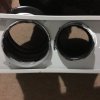wanted1180
Active Member
Hi Guys n Gals I’m in need of abit of advice.Ok I have a 740 cfm 8 inch Centrifugal with 8 inch insulated ducting the fan is pulling air through a xxl air cooled hood 1000watt hps.So my problem is I only have 2 holes to vent outside one is 4inch the other is 5 inch I cannot make these larger So my question is can i make up some type of a Y one into two so from the end of the 8inch duct I’ll have a Y connector with one venting to the 4 Inch exhaust outlet and the other going to the 5inch so all up I’m venting through 9 inches will this work if not any tips on what to do would be greatly appreciated thanks I’ll put some pictures hopefully that will help you understand what I mean Thanks again WANTED


